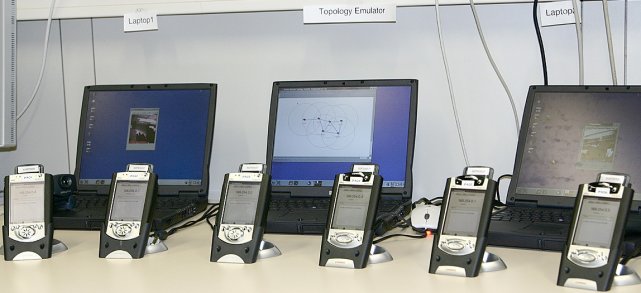Passive Autoconfiguration for Mobile Ad hoc Networks (PACMAN)
Introduction
Mobile ad hoc networks enable the establishment of a communication network independent of any infrastructure in a spontaneous manner. For that purpose, the network must be self-organizing and autoconfiguring. Passive Autoconfiguration for Mobile Ad hoc Networks (PACMAN) is an efficient and robust distributed solution for address autoconfiguration in mobile ad hoc networks.
Special features of PACMAN are the support for frequent network partitioning and merging, and very low protocol overhead. This is accomplished by following a cross-layer/cross-protocol design. For example, PACMAN utilizes the Passive Duplicate Address Detection (PDAD) concept to detect address conflicts based on anomalies in routing protocol traffic.
This webpage collects work related to PACMAN, which was done by Dr. Kilian
Weniger <k.weniger at web.de>, Ingmar Baumgart <ingmar at ibgt.de>
and Prof. M. Zitterbart <zit at tm.uka.de> of the Institut
für Telematik, Universität
Karlsruhe (TH).
The work was part of the project IPonAir.
Implementation
The implementation in C (designed for linux) is available for download at
Sourceforge.

This implementation is part of the demonstrator presented at ACM Mobicom 2004. The picture below shows the demonstrator. Together with the UniK OLSR routing daemon, PACMAN is running on Linux-based Pocket PCs equipped with IEEE 802.11b NICs. A Qt/Embedded-based GUI shows the current IP address and various statistics. A multi-hop topology is emulated by the tool Wireless Network Topology Emulator (WNTE) and visualized by a laptop.

Related Publications
- K. Weniger: PACMAN: Passive Autoconfiguration for Mobile Ad hoc Networks, to appear in IEEE Journal on Selected Areas in Communications (JSAC) Special Issue 'Wireless Ad hoc Networks', March 2005 (Copyright may be transferred without
notice, after which this version may no longer be accessible)
- K. Weniger, I. Baumgart, M. Zitterbart: Passive Autoconfiguration for Mobile Ad hoc Networks (PACMAN), Accepted as demo at ACM Mobicom 2004, Philadelphia, USA, September 2004
- K. Weniger, M. Zitterbart: Address Autoconfiguration in Mobile Ad Hoc Networks: Current Approaches and Future Directions, IEEE Network Magazine Special issue on 'Ad hoc networking: data communications & topology control', July/August 2004
- K. Weniger: Passive Duplicate Address Detection in Mobile Ad hoc Networks, In Proceedings of IEEE Wireless Communications and Networking Conference (WCNC) 2003, New Orleans, USA, March 2003
Related Links
Last modified: Tue Nov 9 16:23:45 CET 2004

